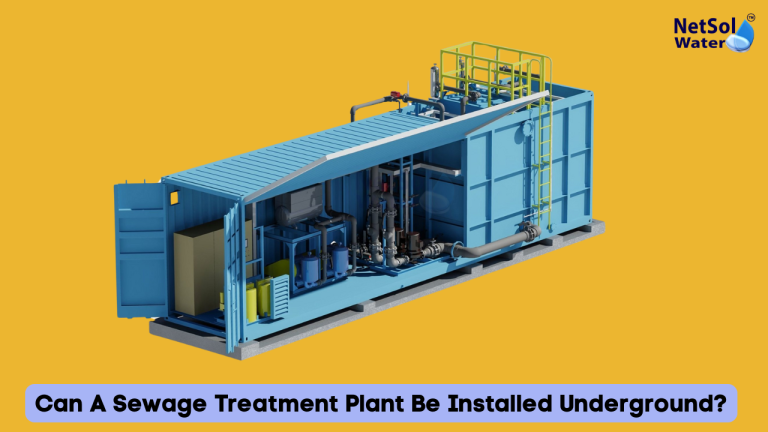
Many people enquire if it is feasible or not feasible to set-up & install sewage treatment plants facility underground. Underground installation of STP Plant is becoming increasingly prevalent as attention is drawn to the lack of available space, environmental preservation, & the preservation of urban & residential areas. Here, we’ll go over & check if installing sewage treatment plant underground is feasible, as well as its related pros & cons, along with what factors should be taken into account before making the decision. In this blog we will discuss about can a sewage treatment plant be installed underground.
Indeed, an underground sewage treatment plant is entirely feasible & is in operation in the majority of places worldwide, where commercial RO plants also provide the similar function. We are now able to construct tiny yet efficient STP plants that can be installed underground without sacrificing efficiency because to advancements in technology & construction.
Why Install STP Plants Underground?
1) Space Conservation: In urban & developed areas, land is expensive & also in short supply. The sewage treatment plants underground location frees up important surface area for structures, parks, or parking lots.
2) Visual Appeal: Sometimes, outdoor treatment plants have an unpleasant odor & are unclean. The plant is hidden by its underground placement, which also keeps the surrounding area looking more appealing.
3) Noise Reduction: Pumps & blowers are examples of mechanical devices that can produce noise. Noise emissions are significantly reduced because the plant is underground & the earth itself serves as a sound barrier.
4) Temperature Control: Because underground spaces have consistent temperatures all year round, they are ideal for microbiological treatment systems that need to operate within a specific temperature range in order to function at their best.
5) Safety: Being underground provides protection against weather-related disasters, damage, or unintentional damage.
The Difficulties of Finding Underground Sewage Treatment Plants
Despite the many advantages of having a STP Plant installed underground, there are still several issues that need to be carefully considered:
1) Higher Initial Costs: When compared to traditional over-ground systems, the initial cost is higher due to the need for excavation, reinforced framework, & waterproofing.
2) Maintenance along with Easy Access: Underground conceptions prevent timely repair, maintenance, plus periodic inspection. There must be enough access points, including vents, ladders, & manholes.
3) Problems with the water table: The subterranean or underground tank or chamber is sensitive to soil settling or flooding in regions with high groundwater tables. Drainage & waterproofing systems need to be installed specifically.
4) Proper Exhaust for Ventilating & Odour Control: Harmful Gases as well as odours are produced as a result of sewage treatment. To prevent the underground plant from causing discomfort or posing a health risk, efficient ventilation & odor control measures must be put in place.
5) Structural Integrity: Underground structures must be strong enough to support soil pressure plus any surface loads, such as construction or traffic.
Important Factors that Cannot be ignored for a Sewage Treatment Plant to be Installed Underground
Keep in mind these crucial elements if you intend to have an underground sewage treatment plant installed specifically by Commercial RO Plant:
1) Architecture & Their Designs
STP plants assembled & installed underground are expertly designed & placed by knowledgeable professionals. The plant should be durable, watertight, & easy to maintain due to its design. The materials chosen should be resistant to chemicals & corrosion.
2) Considerations for Selecting the Good Soil & Site
Before installation, a thorough evaluation of the site’s features, groundwater, including soil type must be finished. Clay & various other soils have the potential to absorb water, which might result in hydrostatic pressure.
3) Systems of Air Vent as well as Safety
For maintenance workers who must enter the facility, adequate ventilation prevents gas buildup, controls odors, & gives out clean air. It is imperative to stick on to the constrained space admission & security procedures.
4) Conformance to System
It is important to follow municipal & environmental building regulations. Permits are usually needed for sewer discharge along with underground development.
5) Prospective Growth as well as Capacity
It is necessary to design for future requirements. In order to accommodate increased demand, the facility must be easily scalable or developed with modular architecture.
Pros or benefits of Sewage Treatment Plant Installed Underground
1) On-Ground Space Efficiency: Allows for optimal use of available space in cities.
2) Aesthetic Benefits: Keeps the space tidy & aesthetically pleasing.
3) Minimal Noise & Almost No Odor: Enables nearby residents to live comfortably.
4) Weather Protection: Reduced exposure to storms, wind, rain, & sun.
5) Long-Term Durability: Because underground installations are better insulated, they often last longer.
Conclusion
An underground sewage treatment facility is a practical as well as advantageous alternative, especially in situations where surface area is limited but aesthetics are important. The advantages of reduced noise alongside odour, increased surface area, & protection from environmental exposure outweigh the initial expense & design attention to detail.
An underground installed STP Plant by Commercial RO Plant must be carefully laid out, designed, & built by qualified engineers, architects, & contractors if one is to be established. Your underground sewage treatment plant will operate in a secure manner for many years to come if the facility is planned for, sited appropriately, & safety-environmental guidelines are followed.
